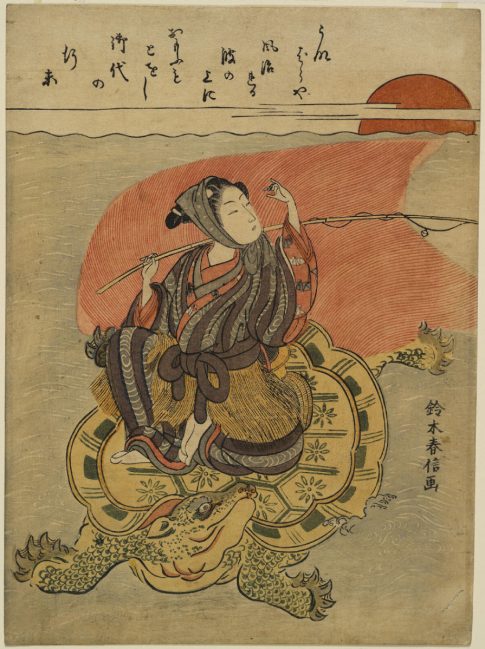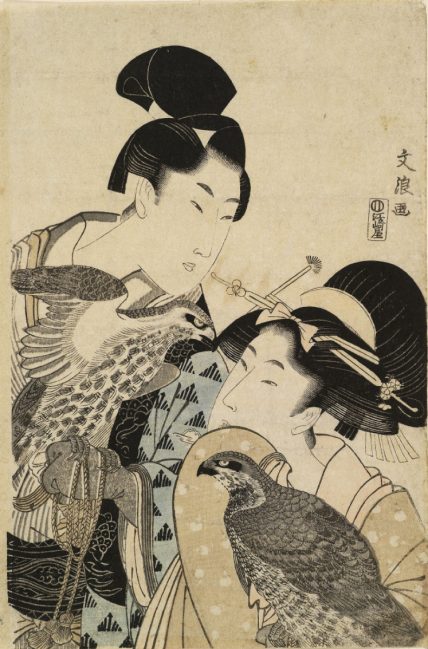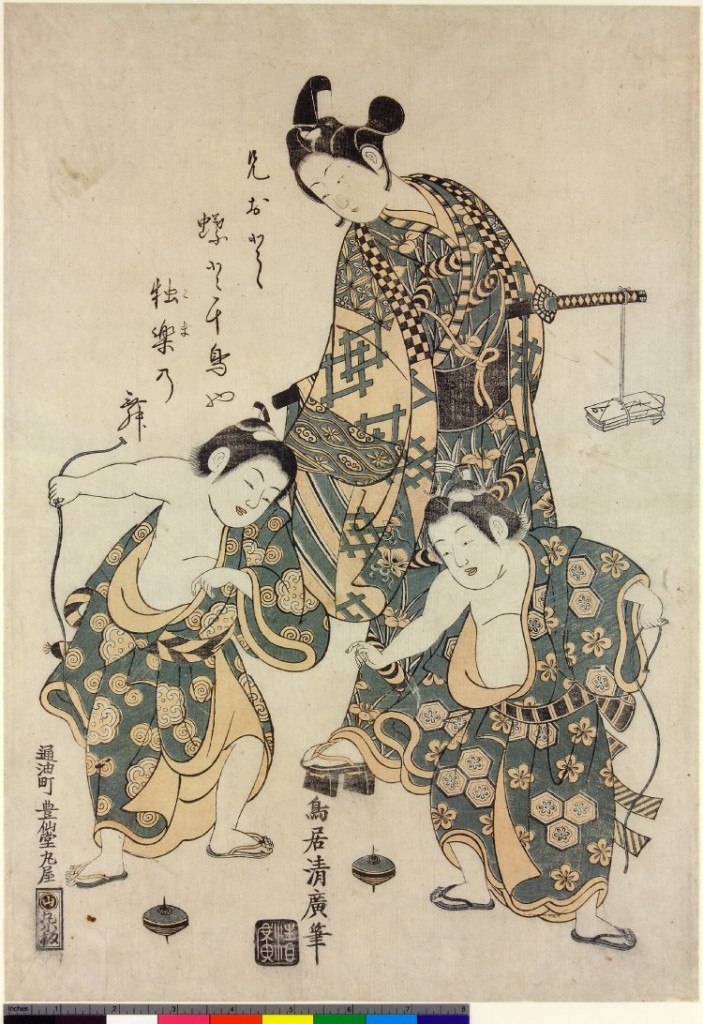
YOUTH MARKS BOTH A period of transience and the promise for a future, existing within a state of becoming. What is the value of an identity that is defined by a period of becoming? The figure of the youth has historically been able to resist the categories of male, female, boy, girl through the process of self-fashioning. This resistance of gender categories is not simply a rejection of the control mechanisms of culture but also requires working within the existing cultural system of images. During the Edo period of Japan between 1603 and 1868, the distortion of gender categories was an encounter between the authority of a rigid society and the desire to subvert Edo society by cultivating the image of the self.
The gender ambiguities that existed within Edo Japan were visually codified in the eighteenth century with the emergence of the concept of nigao–e or ‘face-resembling pictures’: the imitation of an image, thereby constructing identities through images. This translation may seem awkward, but it suggests that images construct identities and that identities can only exist if there is an image to reinforce them. Our knowledge of what is male, female or in-between, comes to us through the images that are disseminated within our societies. In eighteenth century kabuki theatre, nigao-e was adopted in order to make the characters on stage more visually readable by the audience. Distinctive features were developed for specific roles, including the shape of the mouth, nose and eyebrows, creating a striking resemblance between the character and the subculture that they were representing. The likeness of the character to an existing image held greater importance than the psychology of the character that these actors were portraying. One of these characters in kabuki was the wakashu, traditionally played by teenage boys and representing a specific subculture within Edo Japan. Wakashu are described by kabuki scholar Imao Tetsuya as ‘floating between the polarities of male and female, synthesising the principle of both sexes.’1 The wakashu, etymologically resisting gender identification, is translated into English most closely as ‘youth,’ constituting what many scholars consider a ‘third gender.’2 Through the self-fashioning of their image, wakashu were able to resist gender identification, existing as a third gender within a state of becoming. By rejecting the imposed male identity, wakashu represented the possibility of an existence outside of Edo society along with the prospect of future transformation for Edo culture.
Although within language the definition of wakashu is extremely ambiguous, within visual culture and in kabuki theatre, the wakashu had a very distinct appearance so that spectators could identify this figure as existing outside of male and female identities. Wakashu are most easily recognised within visual culture by the small shaven patch on the top of their head (maegami), peeking behind their forelock which was pulled back over the head. This attribute allows viewers to distinguish wakashu from men, who shaved the top of their heads completely bald. The maegami also allows the viewer to distinguish wakashu from women. Wakashu are often dressed in almost identical clothing to those worn by young unmarried women: formal long-sleeved furisode robes, worn both in visual representations and on stage. In kabuki theatre, wakashu often played the role of the futanarihira, literally ‘the doubled body,’ referring to a state of becoming by moving between genders, also known as the ‘androgynous stunner.’3 Wakashu on stage are usually represented with a kerchief tied around their head covering the forelock and dressed in the female fursiode robes, making their gender even more ambiguous. While the civilian wakashu constituted another gender – a third gender – the professional wakashu of the kabuki theatre oscillated between male and female.4 The duality of the wakashu’s image was not a total rejection of male identity, but rather represented a state of becoming which followed the flow of their coming of age. The wakashu identity allowed male youths to represent not only a third gender but an alternative social class within Edo society.

The youthfulness of the wakashu not only characterised their transition from boy to man but was also a way of existing outside the social hierarchy of Edo society. Wakashu flourished during a period in which male social mobility was strongly discouraged. Wakashu, especially those within kabuki theatre, were often prostitutes and were depicted by Edo artists such as Suzuki Harunobu in amorous situations with both men and women, making it difficult to differentiate between wakashu and wakashu-prostitutes. Wakashu are often represented as prostitutes in visual culture because of kabuki theatre’s long history as both a place for theatrical and sexual entertainment.5 Although restricted by social class and occupation, wakashu experienced a different kind of mobility through the act of moving between, and existing outside gender. After wakashu reached the age of nineteen or twenty and transitioned into adulthood, they assumed an unmovable place as adult males within society. With the radical Westernisation of Japan during the Meji era (1868–1912), and the adoption of Victorian norms of gender and sexuality, representations of masculinity became more rigid, and the image of the wakashu disappeared from visual culture outside of kabuki theatre.6 Wakashu represented a period of fantasy in which youths were able to modulate the male identity and the restrictions of the Japanese social hierarchy. The image of the wakashu was codified and constructed within Edo society while resisting gender categorisation, existing between identities in the state of becoming.
Self-fashioning is the action of taking existing images circulating within a culture and creating one’s own image through them. Historian Stephen Greenblatt has applied the notion to Renaissance culture, describing in Renaissance Self-Fashioning how the fashioning of the self was inseparable from the fashioning of society.7 For Greenblatt self-fashioning is the process of constructing one’s identity in accordance with existing social norms. Similarly, it could be argued that the wakashu was able to exist in-between genders through the process of self-fashioning within an existing economy of images. Comparable to face-resembling-pictures, self-fashioning is aligned with representation, thereby presenting an ideal state rather than a reality. This third gender still requires an image that is identifiable in order to fashion itself outside of their social existence.
The re-fashioning of one’s image, at the same time, has the power to rupture how we understand identity and its relationship to society. In philosopher Michel Foucault’s discussion of sexuality in the Western world, The History of Sexuality, he asserted that self-fashioning was a response to a crisis in culture, which was for him also a crisis of the subject.8 For Foucault, self‐constitution and cultivation were what stood against the normalising machine of modern technologies. Both self-constitution and cultivation are processes of becoming through self-fashioning.9 Within every cultural crisis the desire to reconstruct life anew is as much a reconstruction of the social body as it is a reconstitution of the physical body. The desire to become a wakashu – beyond sexual orientations – could then be seen as the wish to resist the social body through the fashioning of the self outside of its imposed construction – a yearning that appears not to abate with neither time, geography nor culture.

Alice Tallman is an independent editor and writer based in New York. She assisted with the editing of the publication accompanying the recent exhibition at the Royal Ontario Museum, A Third Gender.
M Morinaga, ‘The Gender of Onnagata As the Imitating Imitated: Its Historicity, Performativity, and Involvement in the Circulation of Femininity’ in Positions: East Asia Cultures,10 (2), Fall 2002, p. 253, quoting Imao, Henshin no shisō, p.146. ↩
A Ikeda & J Mostow, A Third Gender, Toronto, Royal Ontario Museum Press, 2016 ↩
M Morinaga, ‘The Gender of Onnagata As the Imitating Imitated: Its Historicity, Performativity, and Involvement in the Circulation of Femininity’ in Positions: East Asia Cultures, 10 (2), Fall, 2002, p. 253 ↩
J Mostow, ‘Wakashu as a Third Gender and Gender Ambiguity Through the Edo Period,’ A Third Gender, Toronto, Royal Ontario Museum, 2016, p. 26 ↩
M Morinaga, ‘The Gender of Onnagata As the Imitating Imitated: Its Historicity, Performativity, and Involvement in the Circulation of Femininity’ in Positions: East Asia Cultures, 10 (2), Fall 2002, p. 253-254 ↩
A Ikeda, ‘Introduction’ in A Third Gender, Toronto, Royal Ontario Museum, 2016 p. 11 ↩
S Greenblatt. Renaissance Self-Fashioning from More to Shakespeare, Chicago, University of Chicago Press, 1980 ↩
M Foucault, ‘The Care of the Self’ in The History of Sexuality, 3, R Hurley (trans), New York, Pantheon Books, 1986. ↩
M Foucault, L’herméneutique du sujet, Cours au Collège de France, ed, Frédéric Gros, Paris, Gallimard/Seuil, 2001, p. 490-93. ↩